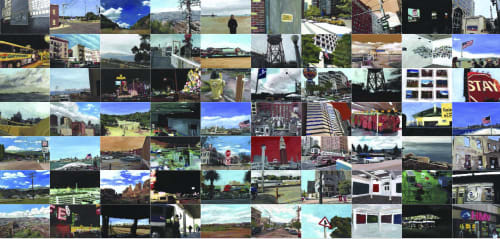After Kafka's Amerika: Hallward Gallery, Dublin, Ireland
Eamon O'Kane's richly productive project AKA: After Kafka's Amerika has generated a profusion of art works in a range of media that includes painting, photography and video. Famously, Franz Kafka relied on secondary source material when writing his novel, Amerika, as he never actually visited the USA.
Eamon O'Kane's richly productive project AKA: After Kafka's Amerika has generated a profusion of art works in a range of media that includes painting, photography and video. Famously, Franz Kafka relied on secondary source material when writing his novel, Amerika, as he never actually visited the USA. In keeping with this preference for imaginative projection over recorded experience AKA, the video is prefaced by a cautionary epigraph from the critic Jonathan Culler: 'Things are never expected to be real; rather things are read as signs of themselves, idealized and often frustrated.' There follows a dizzying sequence of static snapshots, which takes the viewer on a rollercoaster ride from the heart of America's great cities to the breathtaking expanses of its desert wildernesses. A number of these snapshots have also been excerpted from this sequence and are presented as lone images, inviting a more contemplative form of address on the viewer's part. O'Kane has also produced an extensive series of small acrylic paintings derived from a mixture of sources inspired by kafka's novel, including images culled from books and the internet, taking us even further afield from any notion of precisely recorded reality.'
Dr Caoimhin Mac Giolla Leith, 2005
Hallward Gallery, 65 Merrion Square, Dublin 2, Ireland
AKA (After Kafka's Amerika): Eamon O'Kane, Hallward Gallery until May 11th (016621482);
Eamon O'Kane is an artist of prodigious energy and application, and his Hallward Gallery show, AKA (After Kafka's Amerika), is testament to these qualities, comprising well over 200 individual works. Admittedly, most of them are more or less postcard size, but every such "postcard" is a painted, snapshot-like representational image, so we're talking about an enormous investment of time and effort. These images look like paintings of photographs, which invites the question: why not use the photographs?
The show's title refers to Kafka's imagined America, a dream of freedom, hope and wide open spaces - albeit in a Kafka-esque vein - dreamt by someone who never actually left Europe, never mind reached the New World. O'Kane's images read like a travelogue, a wide-eyed, excited documentation of everything archetypically American. You don't have to accept Jean Baudrillard's thesis - that the US is more or less a theme-park representation of itself, it is Disneyland - to recognise that when you encounter it you will inevitably match the real thing with the endlessly represented, endlessly mythologised America you carry in your head.
So it could be that O'Kane is offering us layers of representation: America filtered through Kafka's imaginings and his own preconceptions, paralleled by his matter-of-fact exploration of the place, with the implication that we can never quite get beyond those representational layers. There is, though, a distinctly affirmative air to his sightseeing, a sense that he believes America's promise of reinvention and happy endings. Yet in the end, in a very American way, the sheer logistics of the work in his show seem to outweigh the pay-off.
https://www.irishtimes.com/culture/cautionary-tales-of-a-gallery-guide-1.306895












